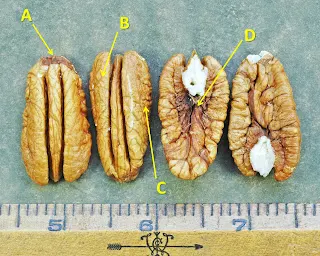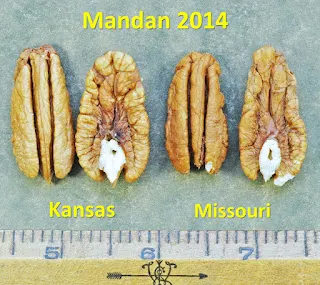 |
| Mandan Pecan. Photo by Bill Reid |
I don't want to make this post any longer than necessary. I am not a pecan expert. Bill Reid is.
Pecans need a lot of water
 |
| The kernels on the right were negatively impacted by dry growing conditions when the kernel was filling. |
To cut to the chase, the established trees are quite drought resistant BUT the prices the grower will get from the cracker will be negatively impacted if the kernels are small, shriveled, wrinkled, cup-shaped, dark-skinned or otherwise imperfect.
Bill Reid posts an article HERE explaining why Mandan is not a good choice for a commercial pecan orchard. I think most home-growers would be thrilled to have a Mandan tree in their yard.
American consumers buy with their eyes and pay more, sometimes much more, for products that are visually attractive. That can be the difference between a profitable pecan orchard and a money-pit.
If you live in the warmer parts of USDA Zone 6 (or even warmer) and want to grow a couple of pecan trees in your yard you can probably find several varieties that will satisfy you as a producer for your own households use.
One key point is WARMER. Pecans are warm-blooded beasts and are fussy about filling if the temperature turns cool. The west coast of Michigan, close to Lake Michigan is Zone 6 but it is definitely not warm compared to southern Indiana which is also Zone 6.
Zone 5 pecans
I live about 75 miles from Lake Michigan and I am colder in the winter and warmer in the summer than the folks closer to the big lake.
My driveway is lined with pecan trees BUT they produce pee-wees since the seed-nut source was northern Illinois and eastern Iowa. The nuts are genetically wired to produce small nuts.
The nuts fill enough such that I have seedling pecans sprouting up in the yard but they are difficult to crack because of the kernel geometry.
Bill Reid on some Northern Pecan cultivars
Bill Reid on some recent releases from the Kansas breeding program
Bill Reid on Canton Pecan (one of the cultivars he recommends for growers who are cheating a little-bit on season length/warmth)
It is worth noting that Bill Reid often advises people in marginal pecan zones to consider to Shellbark Hickory or one of the better Black Walnut cultivars. I know of a Shellbark tree in Birch Run, Michigan that produces annually and Fargo, North Dakota has many, very productive Black Walnut trees.
A list of pecan cultivars. Links lead to short descriptions of the variety.
Down here, along the Guadalupe River, there are pecan growers with natural irrigation. That would be around Seguin, Tx. There was a huge orchard out west on Hwy 57 and FM 140 By La Pryor. It was there before San Antonio was very big. They had dikes on it, and flooded it at times during the growing season. BUT, San Antonio grew, and got control of the aquifer. They cut water to the orchard years ago. Hundreds of acres of pecan trees. I still think it was unjust.
ReplyDeleteOur family has 40 acres of pecan trees down in south Georgia. They've been producing for going on 100 years!
ReplyDelete"It is worth noting that Bill Reid often advises people in marginal pecan zones to consider to Shellbark Hickory or one of the better Black Walnut cultivars. "
ReplyDeleteDid you mean to say "... consider grafting to..."?
Shellbark Hickory grows very well when grafted on pecan seedlings. I do not expect a Black Walnut would "take".
DeleteMy brain was saying "planting" when my fingers took a shortcut and typed "to".
Good catch. Thanks.